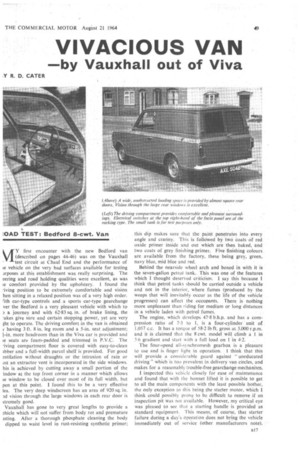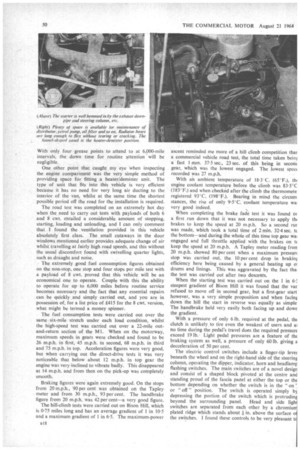VIVACIOUS VAN
Page 53

Page 54

Page 55

If you've noticed an error in this article please click here to report it so we can fix it.
—by Vauxhall out of Viva
-ylY first encounter with the new Bedford van (described on pages 44-46) was on the Vauxhall test circuit at Chaul End and the performance of le vehicle on the very bad surfaces available for testing irposes at this establishment was really surprising. The eering and road holding qualities were excellent, as was le comfort provided by the upholstery. I found the iving position to be extremely comfortable and vision hen sitting in a relaxed position was of a very high order. rith car-type controls and a sports car-type gearchange ver the Bedford is a very pleasant vehicle with which to ) a journey and with 62.83 sq. in. of brake lining, the 'akes give sure and certain stopping power, yet are very ;Iit to operate. The driving comfort in the van is obtained y having 3 ft. 8 in. leg room and a 5-in, seat adjustment; kn. more headroom than in the Viva car is provided and le seats are foam-padded and trimmed in P.V.C. The -lying compartment floor is covered with easy-to-clean ibber and a full-width parcel shelf is provided. For good i:ntilation without draughts. or the intrusion of rain or ast an extractor vent is incorporated in the side windows_ his is achieved by cutting away a small .portion of the indow at the top front corner in a manner which allows le window to be closed over most of its full width, but pen at this point. 1 found this to be a, very effective lea. The very deep windscreen has an area of 920 sq. in. id vision through the large windows in each rear door is ,ttremely good.
Vauxhall has gone to very great lengths to provide a .1licle which will not suffer from body rot and premature 'sting. After a thorough phosphate cleaning the body dipped to waist level in rust-resisting synthetic primer;
this dip makes sure that the paint penetrates into every angle and cranny. This is follOwed by two Coats-of red oxide primer inside and out whichare then baked, and two coats of grey finishing primer. Five finishing colours, are available from the factory, these being grey, green, navy blue, mid blue and red.
Behind the nearside wheel arch and boxed in with it is the seven-gallon petrol tank. This was one of the features which I thought deserved criticism. 1 say this because I think that petrol tanks should be carried, outside a vehicle and not in the interior, where fumes (produced by the weeps that will inevitably occur as the life of the vehicle progresses) can affect the occupants. There is nothing more unpleasant than riding for medium or long distances in a vehicle laden with petrol fumes.
The engine, which develops 47.8 b.h.p. and has a compression ratio of 7-3 to 1, is a four-cylinder. unit of 1,057 c.c. It has a torque of 58-2 lb ft. gross at.3,000 r.p.m. and it is. claimed that the 8 cwt. model will climb a 1 in 3-6 gradient and start with a full load on I in 4.2.
The four-speed ali-synchromesh gearbox is a pleasure to use and is finger light in operation. I think that this will provide a considerable guard against " uneducated driving which is too prevalent in delivery vancircles, and makes for a reasonably trouble-free gearehange mechanism.
I inspected this vehicle closely for ease of maintenance and found that with the bonnet lifted it is possible to get to all the main components with the least possible bother, the only exception to this being the starter motor, which I think could possibly prove to be difficult to remove if an inspection pit was not available. However, my critical eye was pleased to see that a starting. handle is provided as standard equipment. This means, of course, that starter failure during a day's operation does not bring the vehicle immediately out of service (other manufacturers note).
With only four grease points to attend to at 6,000-mile intervals, the down time for routine attention will be negligible.
One other point that caught my eye when inspecting the engine compartment was the very simple method of providing space for fitting a heater/demister unit. The type of unit that fits into this vehicle is very efficient because it has no need for very long air ducting to the interior of the van, whilst at the same time the shortest possible period off the road for the installation is required.
The road test was completed on an extremely hot day when the need to carry out tests with payloads of both 6 and 8 cwt. entailed a considerable amount of stopping, starting, loading and unloading, and I can only comment that I found the ventilation provided in this vehicle absolutely first class. The small cutaways in the door windows mentioned earlier provides adequate change of air whilst travelling at fairly high road speeds, and this without the usual discomfort found with swivelling quarter lights, such as draught and noise.
The extremely good fuel consumption figures obtained on the non-stop, one stop and four stops per mile test with a payload of 8 cwt. proved that this vehicle will be an economical one to operate. Couple with this the ability to operate for up to 6,000 miles before routine service becomes necessary and the fact that any essential repairs can be quickly and simply carried out, and you are in possession of, for a list price of £415 for the 8 cwt. version, what might be termed a money spinner.
The fuel consumption tests were carried out over the same six-mile stretch under each load condition, whilst the high-speed test was carried out over a 22-mile outand-return section of the Ml. When on the motorway, maximum speeds in gears were checked and found to be 26 m.p.h. in first, 45 m.p.h. in second, 68 m.p.h. in third and 75 m.p.h. in top. Acceleration figures were very good, but when carrying out the direct-drive tests it was very noticeable that below about 12 m.p.h. in top gear the engine was very inclined to vibrate badly. This disappeared at 14 m.p.h. and from then on the pick-up was completely smooth.
Braking figures were again extremely good. On the stops from 20 m.p.h., 90 per cent was obtained on the Tapley meter and from 30 m.p.h., 93 per cent. The handbrake figure from 20 m.p.h, was 42 per cent—a very good figure.
The hill-climb tests were carried out on Bison Hill, which is 0,75 miles long and has an average gradient of 1 in 10-5 and a maximum gradient of 1 in 6.5. The maximum-power
ascent reminded me more of a hill climb competition that a commercial vehicle road test, the total time taken he'lll a fast 1 min. 37-5 sec., 23 sec. of this being in secone gear, which was the lowest engaged. The lowest spec( recorded was 27 m.p.h.
With an ambient temperature of 18.3C. (65°F.), thl engine coolant temperature before the climb was 83-5`C (183°E.) and when checked after the climb the thermomete registered 93°C. (198'F.). Bearing in mind the circum stances, the rise of only 95°C. coolant temperature wa very good indeed.
When completing the brake fade test it was found Or a first run down that it was not necessary to apply thl brakes to keep the speed at 20 m.p.h. So a second rut was made, which took a total time of 2 min. 32-4 sec. te the bottom—and during the whole of this time top gear wa. engaged and full throttle applied with the brakes on te keep the speed at 20 m.p.h. A Tapley meter reading fron 20 m.p.h. showed 80 per cent when a maximum pressurt stop was carried out, the 10 per cent drop in brakim efficiency here being caused by a general heating up cr drums and linings. This was aggravated by the fact tha the test was carried out after two descents.
When the starting test was carried out on the 1 in steepest gradient of Bison Hill it was found that the var refused to move off in second gear, but a first-gear start however, was a very simple proposition and when facing down the hill the start in reverse was equally as simple The handbrake held very easily both facing up and dowr the gradient.
With a pressure of only 6 lb. required at the pedal, the clutch is unlikely to tire even the weakest of users and au no time during the pedal's travel does the required pressure exceed 19 lb.Light pedal pressures are a feature of the braking system as well, a pressure of only 60 lb. giving a deccele ration of 50 per cent.
The electric control switches include a finger-tip lever beneath the wheel and on the right-hand side of the steering column, operating the dipper, indicator, horn and headlamp flashing switches. The main switches are of a novel design and consist of a shaped block pivoted at the centre and standing proud of the fascia panel at either the top or the bottom depending on whether the switch is in the "on ' or "off " position. The switch is operated simply by depressing the portion of the switch which is protruding beyond the surrounding panel. Head and side ligh switches are separated from each other by a chromiu plated ridge which stands about in. above the surface o the switches. I found these controls to be very pleasant t Ise and consider that their service life should be fairly ong. All the electrical controls can be easily, removed in he event of their requiring replacement. The instruments lie grouped in a panel immediately below the steering ?died and are not masked by the steering wheel spokes. [he arc of the windscreen wipers should not present any noblems in restricted vision as they clear an area approxinately 3 in. above the normal sight line.
.ittle Noise
During the course of the test, one or two slight rattles lad started up and I thought that perhaps these were lirectly coupled with the window winding mechanism in the nearside door, but it was also noticeable that the check links on the rear doors were inclined to flap about. The low level of noise produced by wind passing over the bodywork was very noticeable when the high-speed motorway test was carried out and although the roof interior is not lined there was very little drumming. Most of the noise which was audible during this test seemed to come from the tyres on the road.
All in all the HA van proved to be a very commendable machine and I would think that to use it regularly would present a_very pleasing prospect and ease the arduous task of a delivery-van driver.






















































































































